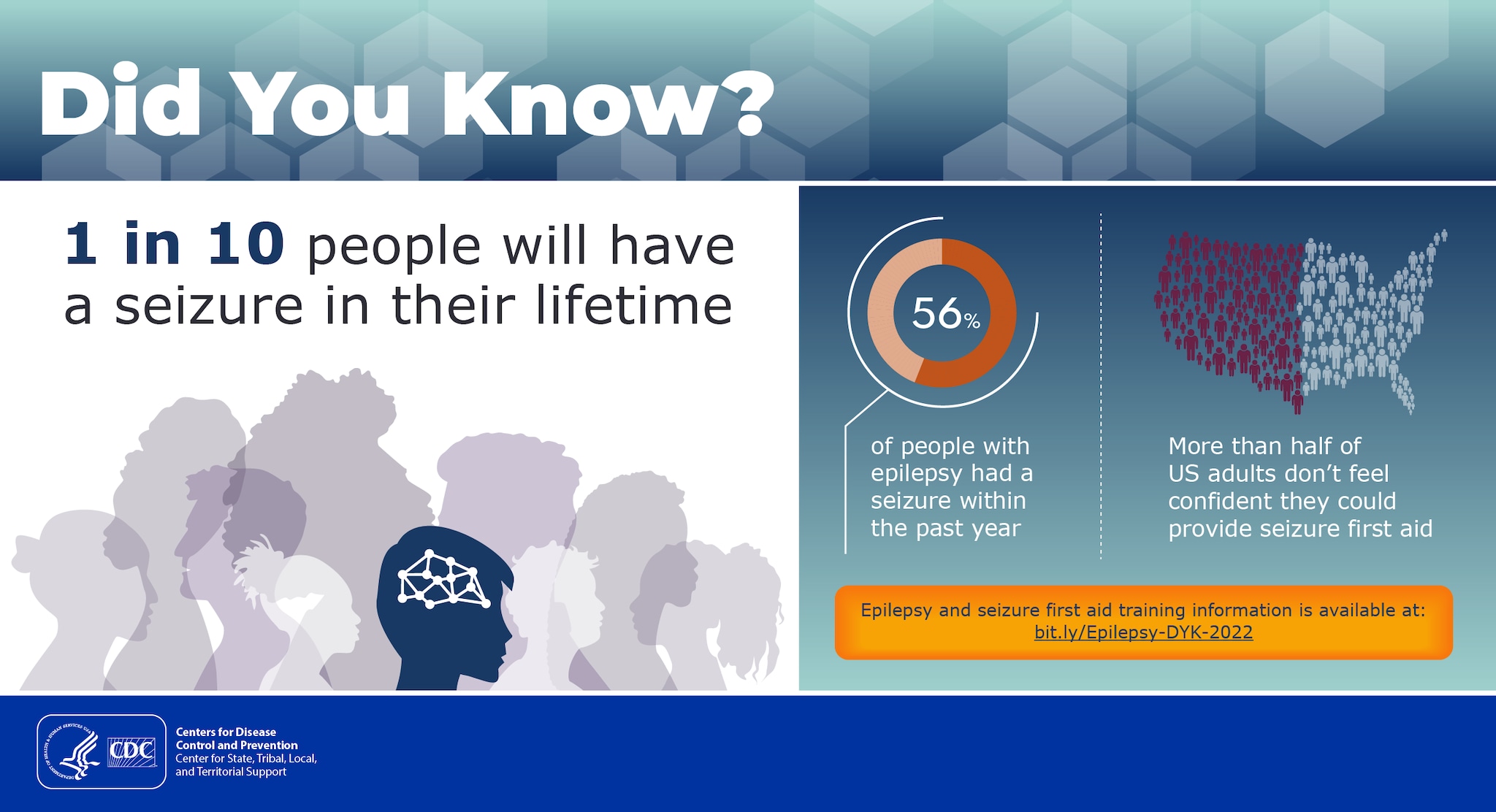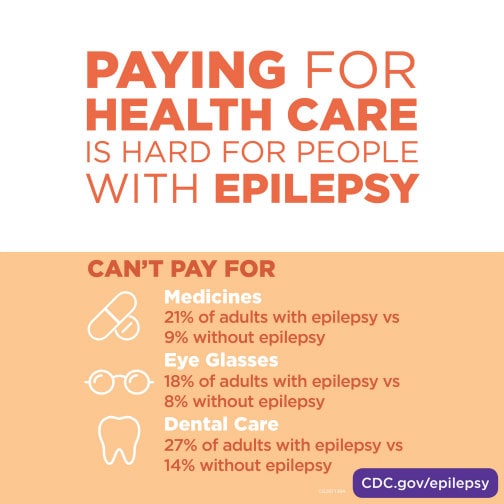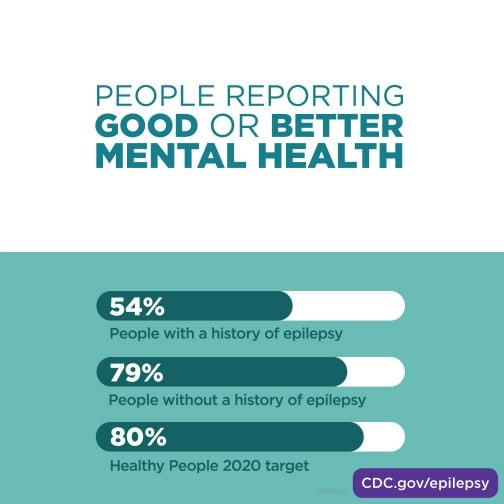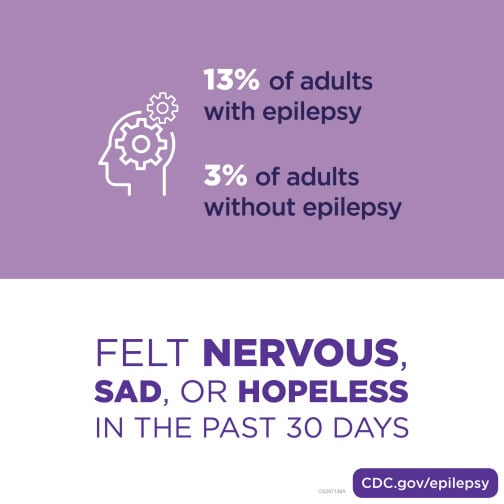Text Descriptions for Infographics

Text Description
Did You Know?
[Illustration of a head and brain]
- 1 in 10 people will have a seizure in their lifetime.
- 56% of people with epilepsy had a seizure within the last year.
- More than half of US adults don’t feel confident they could provide seizure first aid.
Sources:
Tian N, Boring M, Kobau R, Zack MM, Croft JB. Active Epilepsy and Seizure Control in Adults — United States, 2013 and 2015. MMWR. 2018;67:437–442. doi: http://dx.doi.org/10.15585/mmwr.mm6715a1
Hauser WA, Beghi E. First seizure definitions and worldwide incidence and mortality. Epilepsia. 2008;49(Suppl.1):8-12. html.
Hesdorffer DC, Logroscino G, Benn EKT, Katri N, Cascino G. Hauser WA. Estimating risk for developing epilepsy. Neurology 2011;76:23-27. html.
Kobau R, Zack MM. Knowledge of and familiarity with epilepsy in U.S. adults: Results from the 2017 ConsumerStyles Online Panel Survey. Epilepsy Behav. 2021 Jan;114(Pt A):107535. doi: 10.1016/j.yebeh.2020.107535
![Epilepsy-Visual-Abstract-1000 When Seizures Don’t Stop. [Illustration of a head and brain]. Epilepsy is common. 3 million U.S. adults have active epilepsy. 56%26#37; of adults with epilepsy still have seizures. [Illustration of doctor and a nurse standing in a medical office]. A specialist can help stop seizures. 1 out of 3 adults with epilepsy didn’t see a specialist in the past year. Adults with uncontrolled seizures should: see an epilepsy specialist; take medical as prescribed; learn to manage epilepsy; call the Epilepsy Foundation helpline at 1-800-332-1000.](/epilepsy/communications/infographics/images/large/Epilepsy-Visual-Abstract-1000.jpg?_=61680)
Text Description
Epilepsy is common.
[Illustration of a head and brain]
- 3 million U.S. adults have active epilepsy.
- 56% of adults with epilepsy still have seizures.
A specialist can help stop seizures.
[Illustration of doctor and a nurse standing in a medical office]
1 out of 3 adults with epilepsy didn’t see a specialist in the past year.
Adults with uncontrolled seizures should:
- See an epilepsy specialist.
- Take medical as prescribed.
- Learn to manage epilepsy.
- Call Epilepsy Foundation helpline 1-800-332-1000.
Data as of 2015 as published in Tian et al. MMWR. April 2018; https://go.usa.gov/xQjSw

Text Description
Paying for health care is hard for people with epilepsy.
[Illustration of 2 pills]
Adults with epilepsy have more difficulty paying for medicine.
- 21% of adults with epilepsy can’t pay for medicines, compared to 9% of adults without epilepsy who could not pay for their medicine.
[Illustration of a pair of eye glasses]
Adults with epilepsy have more difficulty paying for eyeglasses.
- 18% of adults with epilepsy can’t pay for eye glasses, compared to 8% of adults without epilepsy.
[Illustration of a tooth]
Adults with epilepsy have more difficulty paying for dental care.
- 27% of adults with epilepsy can’t pay for dental care, compared to 14% of adults without epilepsy without dental care.
Sources:
Kobau R, Cui W, Kadima N, et al. Tracking psychosocial health in adults with epilepsy—estimates from the 2010 National Health Interview Survey. Epilepsy Behav. 2014;41:66–73.
Thurman DJ, Kobau R, Luo Yao-Hua, Helmers SL, Zack MM. Health-care access among adults with epilepsy: the U.S. National Health Interview Survey, 2010 and 2013. Epilepsy Behav. 2017;55:184–188.

Text Description
Epilepsy can make it hard to have a job.
[Illustration of a person sitting at a desk and working on a computer.]
32% of adults with epilepsy can’t work, compared with 7% of adults without epilepsy who can’t work.
[Illustration of a car.]
29% of adults with epilepsy can’t use a car or public transit to get places, compared with 8% of adults without epilepsy.
Sources:
Kobau R, Cui W, Kadima N, et al. Tracking psychosocial health in adults with epilepsy—estimates from the 2010 National Health Interview Survey. Epilepsy Behav. 2014;41:66–73.
Thurman DJ, Kobau R, Luo Yao-Hua, Helmers SL, Zack MM. Health-care access among adults with epilepsy: the U.S. National Health Interview Survey, 2010 and 2013. Epilepsy Behav. 2017;55:184–188.

Text Description
People without a history of epilepsy report good or better mental health more frequently than people with a history of epilepsy.
- 54% of people with a history of epilepsy report good or better mental health.
- 79% of people without a history of epilepsy report good or better mental health.
- The Healthy People 2020 target is 80% of people reporting good or better mental health.
Source:
Kobau R, Cui W, Zack MM. Adults with an epilepsy history fare significantly worse on positive mental and physical health than adults with other common chronic conditions—estimates from the 2010 National Health Interview Survey and Patient Reported Outcome Measurement System (PROMIS) Global Health Scale. Epilepsy Behav. 2017;72:182–184.

Text Description
[Illustration of a head with 2 spinning wheels inside of it.]
Adults with epilepsy are more likely to have felt nervous, sad, or hopeless in the past 30 days.
13% of adults with epilepsy felt nervous, sad, or hopeless in the past 30 days, compared to 3% of adults without epilepsy.
Sources:
Kobau R, Cui W, Kadima N, et al. Tracking psychosocial health in adults with epilepsy—estimates from the 2010 National Health Interview Survey. Epilepsy Behav. 2014;41:66–73.
Thurman DJ, Kobau R, Luo Yao-Hua, Helmers SL, Zack MM. Health-care access among adults with epilepsy: the U.S. National Health Interview Survey, 2010 and 2013. Epilepsy Behav. 2017;55:184–188.

Text Description
Kids who have at least one seizure annually also have high rates of living in homes at or close to the poverty level and living in homes with enough food.
336,000 kids have at least one seizure annually.
[Illustration of a house]
4 in 10 kids who had at least one seizure in the past year live in homes at or close to the poverty level.
[Illustration of a fork, plate, and spoon]
3 in 10 kids who had at least one seizure in the past year live in homes without enough food.
Source:
Cui W, Kobau R, Zack MM, Helmers S. Marshalyn Yeargin-Allsopp M. Seizures in children and adolescents aged 6–17 years – United States, 2010–2014. MMWR. 2015;64(43):1209-14.